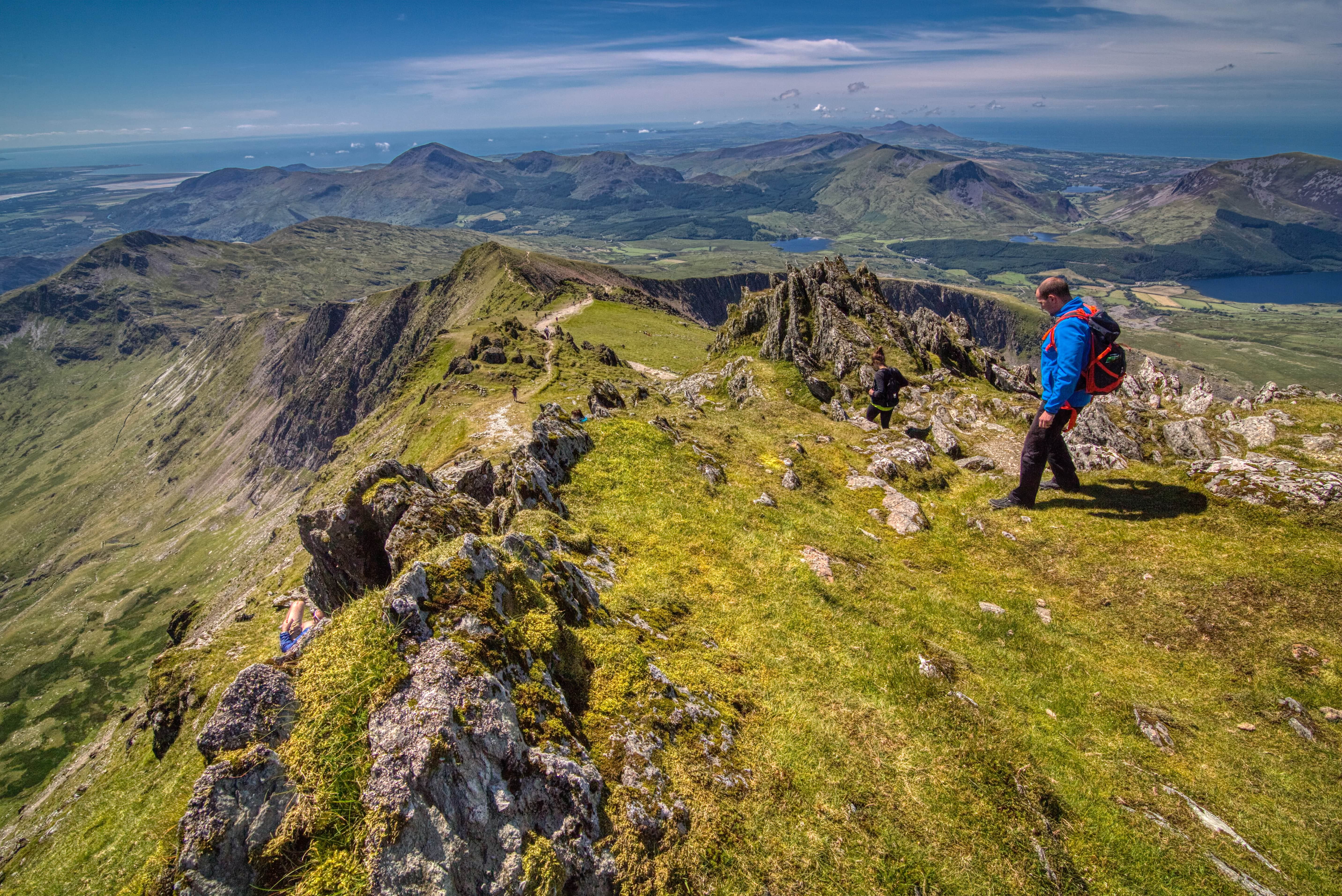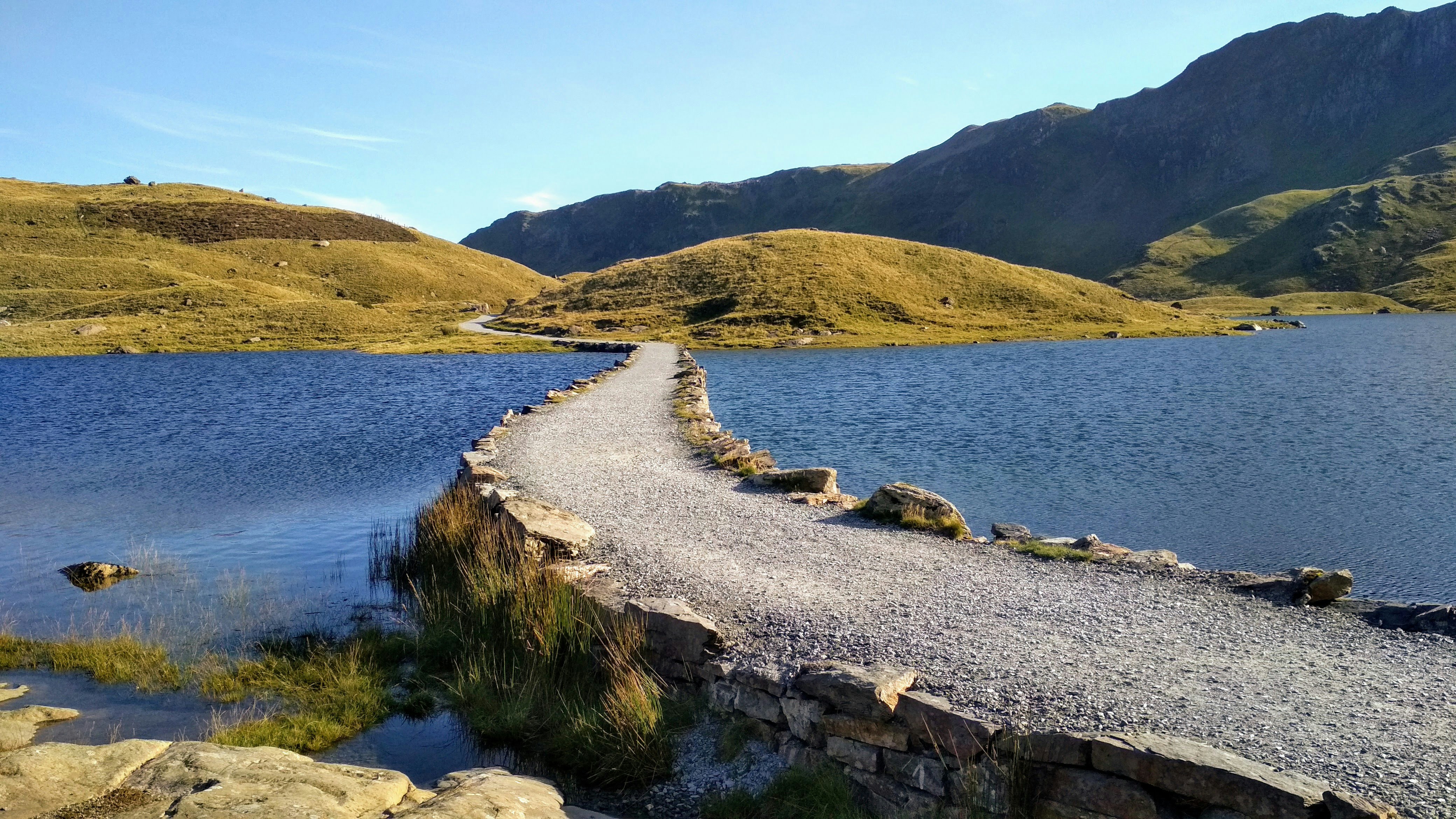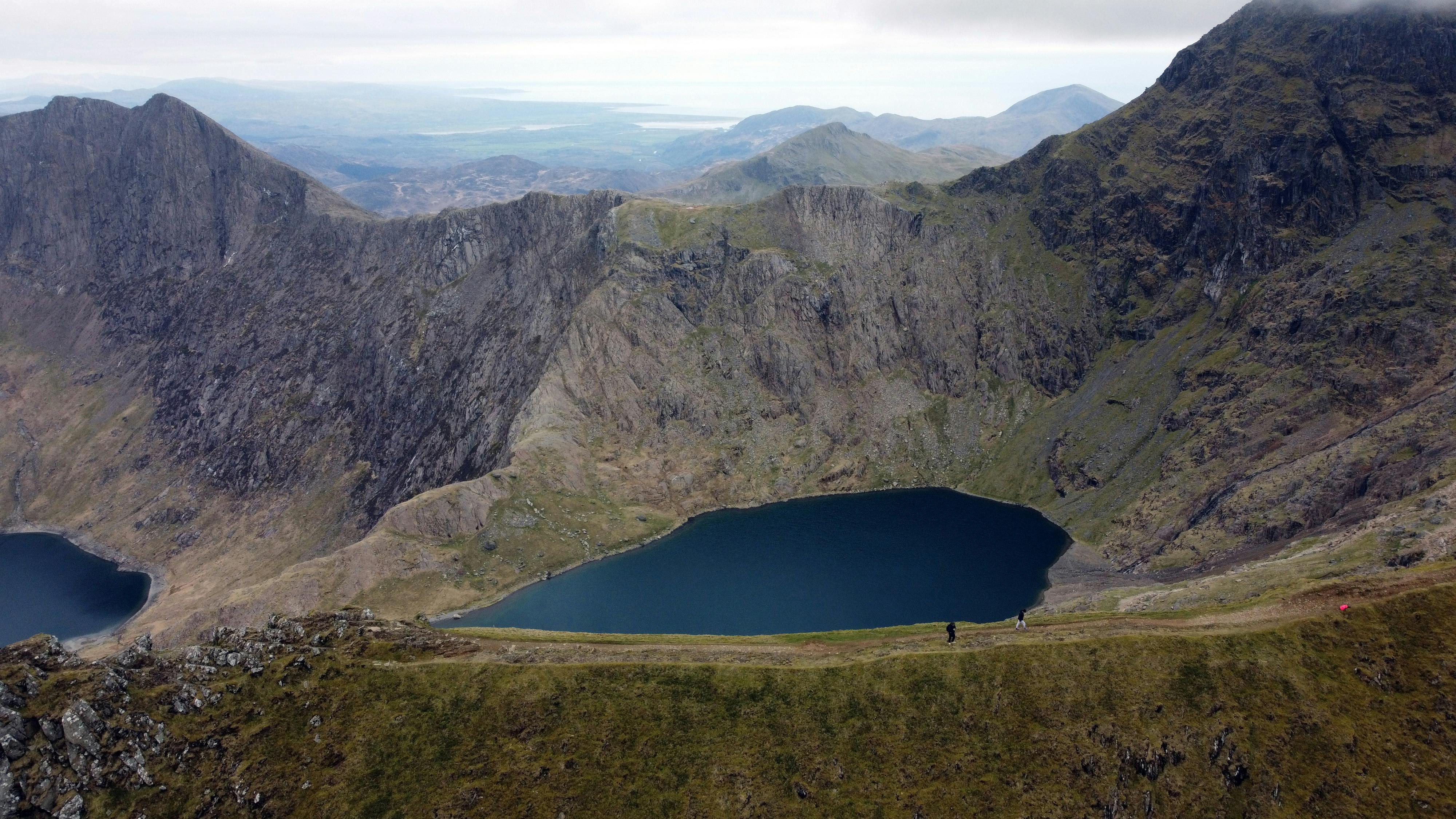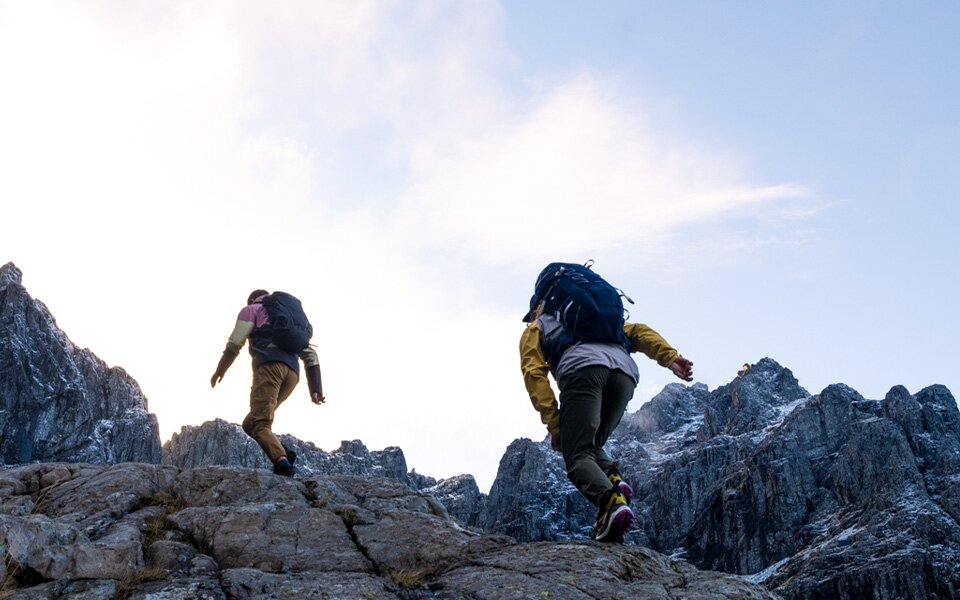Rising to an elevation of 1085 metres (3,560 ft), Mount Snowdon (Yr Wyddfa in Welsh) is the highest mountain in Wales. Part of the Snowdonia mountain range in northwest Wales, Mount Snowdon offers spectacular scenery and is one of the most popular peaks for hiking and climbing in the United Kingdom.
With rugged cliffs, scenic ridges and diverse landscapes across its slopes, Mount Snowdon provides a memorable adventure for visitors. Six main walking routes lead to the summit from different starting points around the mountain. The hiking trails vary in length and difficulty, catering to novice walkers as well as experienced mountaineers.
In clear weather, the panoramic views from the summit are breathtaking. You can gaze over Snowdonia National Park, the Isle of Anglesey and miles of coastline. On a typical day around 500,000 people come to hike Snowdon making it one of the busiest mountains in Britain. Even in poor visibility, simply being on Mount Snowdon is an uplifting experience.
As well as hiking, Mount Snowdon offers other outdoor pursuits like rock climbing, mountaineering, mountain biking and the famous Snowdon Mountain Railway. The mountain environment also supports rare plants and wildlife. From elegant Ramsey Cottage perched near the summit to fossils embedded in the volcanic rock of Clogwyn Dur Arddu (the steep black cliff), Mount Snowdon has many fascinating natural and manmade sites.
This page provides a detailed guide to Mount Snowdon. It covers essential information for visiting include the best hiking routes, weather conditions, accommodation options, travel tips and key facts about the mountain. Whether you’re planning your first hike up Snowdon or visiting the area, this is your complete reference for everything you need to know about majestic Mount Snowdon.
Hiking Routes on Mount Snowdon
With six main routes to ascend Mount Snowdon, hiking trails cater to all levels of fitness and experience. The paths start from different locations around the mountain, varying in length, difficulty and scenery. Even on the easier tracks, climbing Snowdon should not be underestimated. Proper hiking gear, adequate fitness, supplies and monitoring weather forecasts are essential for a safe, enjoyable hike.
Llanberis Path
The Llanberis Path is the longest but gentlest hiking route up Snowdon. Beginning in the mountainside village of Llanberis, the 9 mile (14km) trail gradually zigzags uphill. With an average gradient and no steep or tricky sections, the Llanberis Path suits novice and family groups. However even this “easier” track has rugged, rocky areas especially nearer the summit. Magnificent views open up as you ascend this most popular Snowdon route.
Miners Track
Starting from the Pen-y-Pass car park, the Miners Track offers a more direct line up Mount Snowdon but still ranks as a moderate hike suitable for most abilities. You can also descend via the Pyg Track to create the Miners and Pyg Track circular route. Highlights include passing glacial Llyn Llydaw lake and ruined barracks remnants from the mountain’s former copper mining industry.
Pyg Track
Climbing the rocky Pyg Track route tests fitness levels but doesn’t require mountaineering skills. Setting off from Pen-y-Pass, a steep section past Llyn Llydaw lake leads to easier gradients on the upper mountain. Forming part of the famous Snowdon Horseshoe ridge route, the Pyg Track provides awesome views over Snowdon’s craggy cwms, U-shaped glacial valleys.
Rangers Path
Another peak route accessible to most hikers, the Rangers Path starts from the Snowdon Mountain Railway midway stop at Clogwyn station. After an initially steep climb, the path traverses Snowdon’s western flank over grassy slopes and rocky outcrops. Passing Snowdon Ranger Youth Hostel, it meets the Llanberis Path for the final ascent to the summit.
Snowdon Ranger Path
Sharing much of the Rangers Path but starting lower down, the Snowdon Ranger Path gives a longer days hiking for fit walkers. Beginning at the village of Bethania near Beddgelert, this route switches between defined path and open hillside on its 8 mile (13km) journey to Snowdon’s peak.
Watkin Path
The Watkin Path presents Mount Snowdon’s most challenging hike ascending from Nant Gwynant valley on the west side. Following the path over tricky scree slopes demands stamina and surefootedness but is greatly rewarding. Considered a classic mountaineers route, the Watkin Path stays mainly rocky underfoot all the way up from start to summit.
Climbing & Mountaineering on Mount Snowdon
For skilled climbers and mountaineers, Mount Snowdon’s cliffs, ridges and summits provide superb opportunities to tackle rock faces and ascend sheer precipices. Climbing grades range from easier scrambles to extremely difficult technical climbs. Mount Snowdon’s rock climbing hot spots include Clogwyn y Tarw, Clogwyn y Penmaen, Trinity Buttress and the mighty 1000ft vertical East Face of Clogwyn Du’r Arddu.
Rock Climbing
Rock climbing routes on Mount Snowdon range from scrambling lower grade climbs to very challenging ascents. Snowdon offers multi-pitch climbs as well as single pitch sport climbs. The grey volcanic rock provides rough, grippy climbing but is notoriously loose in places. Always check rock sections carefully and wear a helmet when climbing. Leading authorities provide descriptions of Snowdon’s rock climbing routes.
Popular rock climbing areas on Mount Snowdon include:
- Clogwyn y Tarw with a group of excellent climbing routes suitable for those progressing from easy to very difficult grades of climbing.
- Clogwyn y Penmaen featuring a scary ascent called The Strugglers Route up loose overhanging rock as well as other good climbs.
- Ivy Sepulchre Buttress at Clogwyn y Garnedd in the Nant Peris valley makes a pleasant summer evening crag.
- Trinity Buttress above Llanberis hosts the classic climbing route The Trinity.
- Milestone Buttress on the Watkin Path provides a mountaineering route used to train leaders.
However Mount Snowdon’s most famous rock climbing challenge is the daunting 1000ft precipice Clogwyn Du’r Arddu aka Cloggy. Known as the cliff of the black peak, Cloggy’s imposing East Buttress with routes like The Black Cleft, Thanksgiving Buttress and Curving Crack draws expert climbers to rise to the intimidating vertical rock face.
Mountaineering
For intrepid mountaineers, Snowdon presents superb ridge scrambling over its spectacular rocky cwms and horseshoe summits. The Welsh 3000s mountaineering challenge to climb all 15 Snowdonia peaks over 3000 feet usually starts with scaling Mount Snowdon. Popular ridge routes include:
- The Snowdon Horseshoe: A gruelling 10+ hour mountaineering challenge scaling all seven peaks encircling Yr Wyddfa. Considered one Wales’ finest ridge walks, this strenuous circular route starts at Pen-y-Pass, heads up the Pyg Track, traverses the Crib Goch knife-edge ridge, ascends Garnedd Ugain via Llechog ridge before returning over Y Lliwedd and a descent on the Miners Track.
- Crib Goch: Tackling the Crib Goch ridge forms part of the Snowdon Horseshoe experience. This exhilarating grade 1 scramble stays mainly on the narrow rocky ridge leading along the cliff-lined north face to Garnedd Ugain. Expect some easy climbing passing pinnacles and towers. Always check weather forecasts and take great care in icy conditions when the crumbling ridge terrain can become perilous.
- The Snowdon Horseshoe ‘Direct’: For hardcore mountaineers, this even more demanding variation leaves out Llechog ridge to ascend Garnedd Ugain directly up its steep, exposed east face - a grade 3 scramble with sheer drops requiring surefooted scrambling and climbing skills.
Mount Snowdon presents stern mountaineering challenges. Good fitness levels, expert skills and absolutely meticulous preparation are essential before attempting any difficult ridge routes or steep rock faces.
Mountain Environment & Wildlife on Mount Snowdon
The peaks of Snowdonia formed around 440 million years ago during violent volcanic eruptions flowing lava formations which over millennia have eroded into today’s craggy mountains. Mount Snowdon itself comprises igneous rock - rhyolitic tuffs and lavas from ancient explosive volcanoes plus bands of slate and sedimentary shale. This complex geology remains evident in Snowdon’s distinctive summit rocks.
Ice Ages and subsequent glaciers have also carved Snowdon’s landforms, leaving behind cirques which evolved into cwms plus arêtes and jagged ridges like Crib Goch. Glaciers shaped Snowdon’s six valleys radiating outwards and scooped hollows now forming upland lakes (Llyn) Llydaw, Teyrn and others. Mount Snowdon’s last glaciers melted around 10,000 years ago at the start of warmer interglacial periods allowing vegetation to develop on newly exposed lands.
Today flora and fauna thrive across Snowdon’s varying mountain habitats. Around 600 plant species grow on the mountain some relatively common upland species but also rarities like purple saxifrage, Snowdon lily and chkory-leaved willow. Snowdon’s summit even has its own unique plant the Snowdon lily a small alpine flower that blooms in crevices between rocks just below the very peak.
Lichens and mosses cloak areas of rock, scree and soil helping weather eroding stone into nutrient-rich earth. Snowdon’s woodlands feature oak, ash and wych elm trees on lower slopes with gnarled, stunted trees and shrubs at high elevations twisted into wonderful shapes by extreme weather. Bright gorse, heather moorlands and summer wildflowers like harebells, foxgloves and fritillaries flourish surrounding Snowdon’s peak.
This rare mix of microclimates and geology supports an abundance of mountain wildlife. Hardy Snowdon sheep graze high remote pastures while wild mountain goats roam at home on steep rocky slopes. Smaller herbivores include pygmy shrews and red squirrels in forests and high meadow pipits fluttering over heather. Birds of prey circle Snowdon’s skies - fearsome peregrines, red kites and buzzards plus more elusive golden eagles and hen harriers. Elusive polecats, stoats, weasels inhabit rocky crevices while otters and water voles live around mountain streams.
But climate change now threatens Snowdonia’s biodiversity. Warmer temperatures allow invasive non-native flora and fauna to spread plus more frequent extreme weather causes habitat damage. Torrential rain degrades paths and bridges while Storm Arwen’s fierce winds in November 2021 felled 15% of Snowdonia’s trees - the worst losses in living memory. Conservationists strive to protect ecosystems permitting native wildlife to evolve not just survive global warming impacts. Expanding Snowdon’s natural habitats via wildlife corridors between protected areas aims to safeguard biodiversity and future generations can continue enjoying Snowdonia’s magnificent mountain-scapes knowing we’re caring for its precious nature too.
Ascending By Train - The Snowdon Mountain Railway
First opened in 1896, the Snowdon Mountain Railway is both an iconic attraction and unique transport experience travelling directly to Mount Snowdon’s summit. These days around 140,000 people ride Snowdon’s historic steam and modern diesel trains annually. The rack and pinion railway is the only public transport of its kind in the UK and remains a hugely popular way for people to ascend Mount Snowdon without walking. The railway's lower terminus lies at Llanberis station while the dramatic upper terminus perches just below Snowdon’s peak. The journey covers 4.5 rocky miles (7km) with an elevation gain of 2860 ft (1085m) from valley bottom to mountain top. Powerful locomotives specially constructed for steep inclines haul carriages slowly up gradients as steep as 1 in 5.5 over dramatic Clogwyn tunnels, cascading waterfalls and spectacular views.
Special locomotives designed by Swiss engineers enable trains to climb Snowdon’s steep slopes. “Traditional” original steam trains with eye-catching polished brass pipe-work still run in summer plus modern diesel engines take over for less crowded spring and autumn schedules. Both steam and diesel locomotives use the same rack rail track system where cog wheels grip vertical toothed racks bolted between the rails providing trains enhanced traction to ascend steep slopes without slipping. The railway stops halfway up at Clogwyn station giving passengers time to appreciate surroundings plus stretching legs before completing the onward journey to the summit. On arrival, Snowdon’s upper platforms access leading directly onto hiking trails so passengers can optionally walk down different routes after enjoying panoramic views from the top.
History
Civil engineer George Croydon Marks originally envisioned the idea of a Snowdon railway to transport copper from disused mines below the peak. But the mining venture soon failed so Marks reworked plans for a passenger railway to exploit Victorian tourism. Despite struggles raising funds, local landowner assistance plus hype generated by early publicity kept ambitious plans on track. Swiss rack railway pioneer Enrico Locher partnered to supply locomotives with specialised rack and pinion rail systems guaranteeing trains could operate on extremely steep track gradients.
Initial construction during 1894 took 18 months shifting 200,000 tonnes of rock using pickaxes, explosives and half a mile of extra temporary track to excavate cuttings. Poor weather hampered work completed almost entirely by manual labour. Finally on 6 April 1896, first passenger trains inaugurated the Snowdon Mountain Railway from Llanberis to Snowdon’s summit.
Present Day Operation
These days the Snowdon Mountain Railway operates daily services mid-March to October plus winter weekends. Originally steam trains ran constantly shuttling passengers up and down every 30 minutes but more recently environmental concerns mean diesel engines take over during quieter spring and autumn seasons. Trains stop halfway for a rest plus appreciating spectacular views at Clogwyn station.
Special features include the new ‘Glass Roof’ observation carriage unveiled in 2021 with wrap-around transparent roof for panoramic sightseeing. Train drivers provide commentary highlighting landmarks like Llyn Llydaw lake, ruined barracks, cascading waterfalls and passing mountaineers tackling towering Clogwyn Du’r Arddu (the black cliff). On reaching the summit, Give Your Camera a Rest signs remind visitors to look not just shoot because smartphones rarely capture Snowdon’s immense scale and true majesty.
Visiting Mount Snowdon - Essential Information
This section explains everything you need to know for a safe, enjoyable visit to Mount Snowdon and the Snowdonia National Park area. It provides key details on travel, accommodation, weather plus specific advice to help you make the most of your Snowdon experience.
Getting There
Main access points for Mount Snowdon lie within Snowdonia National Park in the counties of Gwynedd and Conwy. The nearest city is 80 miles (130km) east - Manchester has an international airport and direct trains to reach North Wales faster. Otherwise drive from English cities like Liverpool or Manchester heading to Bangor then following signposts for main Snowdon routes and villages.
Key access points by road are:
- Pen-y-Pass - The circular valley route reaching Llanberis Path (east side), Miners Track and Pyg Track hiking trailheads plus the Snowdon Mountain Railway station. Very limited parking here means many visitors get dropped off enroute to parking further down roads.
- Llanberis – Base for the Llanberis Path route plus railway’s lower terminus station. Also has Dolbadarn Castle ruins and Electric Mountain hydro plant attractions.
- Nant Gwynant – The start point for the Watkin Path on Snowdon’s quieter west flank.
- Beddgelert - Picturesque village near the Snowdon Ranger Path trailhead. Also gateway for scenic drives over Llanberis Pass towards Capel Curig.
- Betws-y-coed – Popular tourist village 15 miles (25km) northeast of Mount Snowdon. Handy stop for hotels/B&Bs when other places are fully booked.
Public Transport
Bus services connect within the Snowdonia region and run from Bangor/Caernarfon to access villages for Snowdon routes. Sherman Valley has a useful bus route map. Most services accept contactless payments but carry change too.
The Conwy Valley railway from Llandudno Junction reaches Betws-y-coed and Blaenau Ffestiniog fringing the national park. Connecting buses go deeper into Snowdonia but services are limited on Sundays.
The Snowdon Mountain Railway from Llanberis remains hugely popular. Book well ahead as trains get very booked especially during peak summer. Some special events sell out immediately so register for advance updates.
Guided Tours
Joining local guide mountain leaders provides safer hiking in challenging weather plus explores less visited parts of Mount Snowdon. Guides share regional insights that enrich your overall experience while their skills handle difficulties so you simply enjoy the mountain trip. Recommended companies include:
- Snowdon Walks
- Adventure Wales
- Mountain Escapes Snowdonia
- Rhys Davies Mountain Guide
When to Visit
Snowdonia’s mountains host fewer crowds during spring and autumn avoiding peak visitor summer months. However off-season trips bring unpredictable weather - check forecasts carefully before hiking higher routes. Winter is very quiet with limited Snowdon facilities open but Snowdonia offers great winter walking/climbing under right conditions.
Spring is ideal for hardy walkers and climbers - quieter trails, snow dusted peaks but sudden storms occur so pack full waterproofs. Late spring gets busier with warmer weather bringing wildflowers.
Summer means large visitor numbers, more facilities open but potential low cloud obscuring high summits. Start hikes early to beat crowds. Overall best chance of warmer, drier weather.
Autumn offers brilliantly clear days for photography between October showers. The fall colours in the trees and bracken make for spectacular scenery. Just be prepared for rain and dropping temperatures if planning long hikes.
Accommodation
Mount Snowdon area offers all types of accommodation from luxury hotels to budget backpacker bunkhouses. Book well ahead for summer weekends. Consider staying in different locations night before and after hiking to avoid driving when tired. Recommended places include:
- Pen-y-Pass YHA Hostel – Iconic 1930s built youth hostel perfectly situated by the Miners Track trailhead with awesome mountain views when cloud clears.
- Rhyd Ddu Lodge – Friendly B&B at the Llanberis Path’s highest road access point so you can start walking without 1500 feet of extra ascent.
- Bryn Gwynant Guest House - Elegant Victorian guest house near the Watkin Path trailhead with fine dining.
- Hotel Eryri – Long established climbers/walkers hotel at Pen-y-Gwryd on the Llanberis Pass road offering real mountain hospitality.
- Pete’s Eats Café – Legendary climbers cafe at Llanberis, open 24/7 serving big hearty plates ideal after Snowdon hikes. Also has accommodation.
- Campsites – Many campsites around Snowdon but book ahead. Recommend Gwern Gôf Uchaf near village Betws-Garmon or Gellilydan site 5 miles from Schiehallion summit.
Weather Conditions
Snowdon’s changeable weather causes many mountain incidents. Conditions vary hugely across different sides of the massif and summit areas get extreme exposure to wind, rain and low cloud. Check detailed forecasts from multiple sources and evaluate against personal capabilities
- Met Office – Get MWIS Mountain Weather forecast reports for North Wales plus summaries from Met Office websites/social media.
- Mountain Weather Information Service (MWIS) – Specialist site detailing conditions on Welsh peaks and ranges. Excellent for Winter reports.
- Weather webcam links - See live summit views via Trinity Mirror Snowdon live streams when cloud clears.
- BBC Weather – Standard forecasts for closest town plus Mountain Forecast tabs shows temperature, rainfall, wind speed variations across mountain areas.
Prepare for worst case with full waterproofs, hat, gloves etc even setting out on seemingly pleasant days where weather can change fast on the mountain.
Key Facts About Mount Snowdon & Surrounding Area
This section shares fascinating details about Mount Snowdon’s history, statistics and nearby places of interest to enhance your understanding and appreciation of majestic Snowdon.
Name Origins
Yr Wyddfa is the Welsh name used locally for Mount Snowdon. It means tumulus or burial mound referring to mythic giant Rhitta Gawr slain by King Arthur then buried on the summit cairn. ‘Eryri’ pronounced eh-ruh-ree is Welsh name for the Snowdonia mountain region meaning ‘the abode of eagles’.
Statistically Speaking
- Snowdon summit elevation: 1,085 m (3,560 ft) makes it highest peak in Wales and England
- Around 500,000 people hike Snowdon annually (over 5,380 ascents weekly)
- Jasmin Paris 2019 record: Ascended and descended all main 6 Snowdon routes in under 23 hours
- Age records: Oldest man age 90 in 2016; Youngest 6 year old girl 2015
- Accumulates up to 4,500 mm annual rainfall (average 1,850mm), similar levels to northwest Scotland
- Snow cover 100+ days a year, can remain until May but rarely severe at peak unlike higher Scottish Munros or Lake District peaks. But winter conditions still need full preparation.
Local History & Myths
This cultural landscape has many ancient sites from Neolithic burial tombs to imposing medieval castles. Age-old Welsh legends about giants and King Arthur involve the mountain plus it's said voices of ghostly monks still haunt St Rhyd church ruins. Periods of copper mining during the 1800s exploited seams below Snowdon’s peak. Remains of barrack buildings now form picturesque lake-side ruins.
Key Places to Visit
- Dolbadarn Castle - Ruins of a 13th century fortified keep set on Llyn Peris lake shore under the Llanberis Pass, once key to controlling the valley route.
- Pen y Pass YHA - The Youth Hostels Association's first ever hostel uniquely positioned right beside mountain hiking trails
- Electric Mountain Visitor Centre - Tours around Dinorwig Power Station showcasing electrical grid load balancing by huge pumped storage reservoirs inside Elidir Fawr mountain nearby.
- National Slate Museum - At Llanberis, this museum is based in a vast disused slate processing quarry and shows North Wales’ industrial heritage.
- Betws-y-Coed - Stunning mountain village packed with outdoor stores makes a handy base. Nearby Swallow Falls has scenic forest walks.
- Beddgelert - Picturesque village supposedly named after Prince Llewelyn’s loyal dog who stood guard over his master’s grave.
Why Experience Mount Snowdon Yourself?
An Iconic Adventure
Simply glimpse the Snowdon peak from across the National Park standing head and shoulders above everything else to understand its magnificence. Get closer walking ancient tracks up slopes that people have ascended for centuries. Feel history in the pursuit where each footstep follows so many before who discovered this magical kingdom.
Escape Into Awesome Nature
Leave behind the ordinary world for Snowdonia’s ever-changing elements. Walk through otherworldly cloud inversions veiling peaks in mystery before emerging above into bright sunshine. Marvel at constantly shifting light painting rocky landforms in different colours. Let cooling winds refresh your spirit as views open up to endless horizons. Give your mind space to wander freely over the natural intricacy all around.
Be Active Outdoors
Experience a deeply satisfying sense of earning the summit after your own physical efforts. Feel fitter each stride upwards, lungs adapting to air getting thinner but body gathering strength. Spot fellow adventurers powering over steep ground and share mutual outdoor camaraderie. Rest awhile to appreciate having time and fitness to embrace living in the present.
Gain Perspective & Inspiration
Rise above real life stresses seeing them shrink relative to epic Snowdon. Lose touch with technology’s distractions to appreciate nature’s complications resolved over eons. Witness geology and climate written into the landscape filled with stories over deep time. Return energised by what endures not annoyed by whatever is transient. Let Snowdon’s sheer spectacle make problems seem smaller but ambitions feel bigger.
Enjoy Spectacular Summit Views
On clear days, Snowdon’s summit delivers truly panoramic sightlines with endless details to pick out. Be thrilled spotting tiny villages, rivers, forests and fainter peaks stretching to distant flat horizons. Watch sunlight and cloud shadows move dynamically across expansive views. Locate places you know while discovering those you’ll explore next time. Just remember the mountain will still be here tomorrow if clag and cloud veil epic views today.
Create Lasting Memories
Looking back from tomorrow the specifics may merge but magical moments remain clearly etched. Recall sights, sounds and emotions felt in the mountains to tap back into why their splendour speaks so deeply. The real magic arises afterwards when favourite snapshots transport your mind straight back to the mountain even years later. Let Mount Snowdon create wonderful memories to cherish forever.
Come ready to be amazed by Snowdon and her secrets will enrich your whole perspective on life in our magnificently complicated world.
Related Articles

Let us know you agree to cookies
We use marketing, analytical and functional cookies as well as similar technologies to give you the best experience. Third parties, including social media platforms, often place tracking cookies on our site to show you personalised adverts outside of our website.
We store your cookie preferences for two years and you can edit your preferences via ‘manage cookies’ or through the cookie policy at the bottom of every page. For more information, please see our cookie policy.










